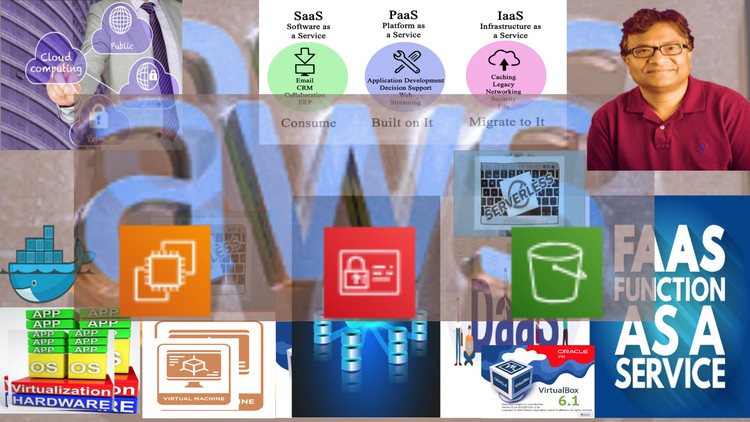
Serverless | Virtual Machine | Hypervisor | IaaS | FaaS | DaaS | Docker | AWS Free Tier | EC2 | S3 | IAM | AWS Security
What you will learn
what is cloud computing; cloud computing types or various mainstream cloud computing platforms such as IaaS, PaaS, SaaS, FaaS, DaaS
sign up for AWS, AWS free tier, AWS billing, how to set up AWS budget alert, hands-on with many AWS services such as EC2, IAM, and S3
AWS Regions, AWS Availability Zones, AWS security and compliance
quiz on various topics which may help you in various AWS certification exams
multitenancy in cloud computing; cloud computing deployment models–public, private, hybrid, community, and multi-cloud
cloud computing applications deployment models
cloud computing advantages
introduction to Virtualization, Virtual Machines, and Hypervisor
how to setup Linux Virtual Machine using VirtualBox
introduction to Docker
introduction to AWS cloud computing platform
Serverless Computing
Description
This course is about cloud computing and AWS Introduction. The covers almost all topics related to cloud computing. Once you have got a solid foundation in cloud computing, then the course starts with what AWS is, and goes into detail about many aspects of AWS with an introductory perspective. You will learn how to sign up for an AWS account, AWS free tier, EC2, IAM, S3, AWS security, and many other related concepts. The course is a good blend of theory and hands-on.
The content in the course presented may help you in many AWS certification exams as many AWS services have been mentioned as an example in explaining the concepts.
There is a separate section for Docker, which will help you to build a solid foundation in Docker at an introductory level.
The course first starts with the introduction section. In this section, you will learn about what cloud computing is and different terms. By end of this first lecture, you will have been familiar with many cloud computing terms and will have gained a general idea about what cloud computing is. The next lecture is about cloud computing platforms types of cloud computing types. In this lecture, you will know about the different main cloud computing platform types.
The next section is about cloud computing platform types. There are lectures for each platform types such as Infrastructure-as-a-Service (IaaS), Platform-as-a-Service (PaaS), Software-as-a-Service (SaaS), Desktop-as-a-Service (DaaS), Desktop-as-a-Service (DaaS), and Function-as-a-Service (FaaS).
The next section is about different cloud computing deployment models. The section starts with an introductory lecture about cloud computing deployment models. Then there is a separate lecture for each cloud computing deployment model including community and multi-cloud.
The next section is about deploying applications on the cloud computing platform; then it follows with a section on the advantages of cloud computing.
The next section is about Virtualization, Virtual Machines, and Hypervisor. The section also includes a lecture on how to install Ubuntu Linux Virtual Machine on Oracle VirtualBox.
The next is about Docker. It covers docker at the introductory level; however since this is a very hands-on section, you will gain very solid foundational knowledge about docker installation on Mac, DockerHub, and day-to-day Docker commands for DevOps.
Once cloud computing is covered, then in the second part we cover the introduction to AWS.
First what AWS is covered, for example, its overview, types of services offered by AWS, and AWS Advantages.
Then the next section is about the AWS account. In this section, you will learn how to sign up for an AWS account, budget alert, best practices for an AWS root account, how to set up MFA, AWS free tier, AWS Billing & Cost Management Dashboard, and accessing the AWS platform.
The next section talks about AWS cloud infrastructure, AWS Regions and Availability Zones.
The following section is about EC2. You will learn how to launch an EC2 instance and set up a web server and other related concepts about EC2.
The next section is about S3. You will get an introduction to S3. You will gain knowledge about the S3 bucket and how to upload objects on S3.
The next section is about the introduction to AWS security and compliance.
The final section is about the AWS cloud computing platform, which will provide you with a good introduction to the AWS cloud computing platform covering many popular AWS services.